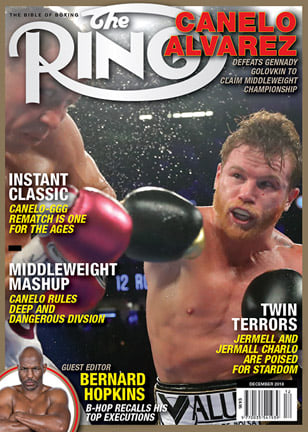The Travelin’ Man returns to Philadelphia…again: Part Two

Please click here to read Part One.
Friday, November 16 (continued): On a night that had its share of the unexpected, welterweight Jaron Ennis made the expected look spectacular.
Coming into tonight’s fight with fellow Philadelphian Raymond Serrano, it was clear that Ennis was a bright prospect but one couldn’t yet answer the question of whether he can become a serious threat to the top men at 147, long among the deepest weight classes in boxing. Yes, Ennis’ 21-0 record included 19 knockouts and, yes, his “ShoBox” debut against the 18-0 Armando Alvarez in July was a smashing success, as he finished the fight with four knockdowns in round three. Still, Alvarez’s undefeated record had been mostly built against opponents with choppy records and because Alvarez subsequently lost his next fight against Livan Navarro on September 28 (L 10), one had to put Ennis’ win over him in perspective – a terrific national TV debut that served to set the table for another step-up fight.
After watching Ennis destroy Serrano in just four minutes and 12 seconds, the youngster is building a compelling case for being the brightest prospect in boxing. One test of a hopeful’s worth is his ability to beat step-up opponents with at least the same level of dominance, as was shown against his record-building foes, but if he improves on it, his chances of stardom and success are further enhanced. Seven weeks earlier, lightweight prospect Devin Haney (following an initial adjustment period) lifted his game and dominated former title challenger Juan Carlos Burgos on his way to a lopsided decision victory but, tonight, the man nicknamed “Boots,” who needed no preliminary assessment, proved he has serious kick in his fists and he used that gift to annihilate Serrano. Not only that, he showcased an array of weapons, all of which carry enormous power. The proof: A compact right hook to the jaw produced the first knockdown while a hair-trigger counter right recorded the second and a pulverizing right uppercut put Serrano down and out. After the first knockdown, the well-schooled Ennis made sure to work the body – even with jabs – so as to force the dizzied Serrano to defend a bigger area. Of course, he couldn’t.
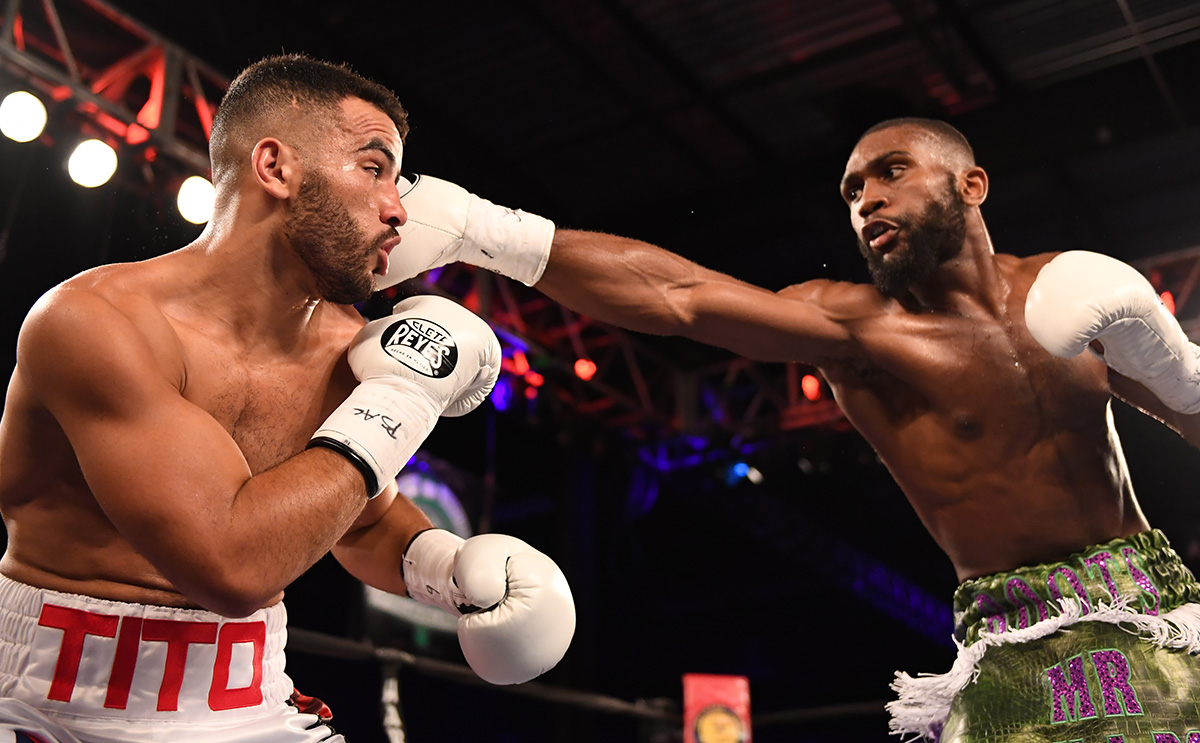
Welterweight Jaron Ennis (right) vs. Raymond Serrano. Photo credit: Matt Heasley
With the victory, Ennis extended his knockout streak to 12 fights, a string of destruction that has brought him to the doorstep of bigger and richer fights against better opponents. While Serrano was seen as a better opponent than Alvarez, he had gone 6-5 with one no-contest after starting his career 18-0 and two of those losses were by KO, so Ennis was expected to win inside the distance. But because of the way he won, Ennis proved to all that the time has come for his worth to be revealed against truly challenging opponents. The fighter himself believes he will not only beat the best; he will excel against them.
“The better my opponent, the better I’m going to be,” he told RingTV.com’s Joe Santoliquito. “I’m ready to step up. Anyone they put in front of me, it doesn’t matter. Whoever they put in front of me, I’m going to stop or make them look bad. I feel like I’m there.
“I’m hoping to be back at the end of January or the beginning of February,” he continued. “I make 147 easy and I’m getting my man strength now. I told everyone (I) was going out there and have some fun. I knew it was going to be early. I knew he couldn’t take my power.
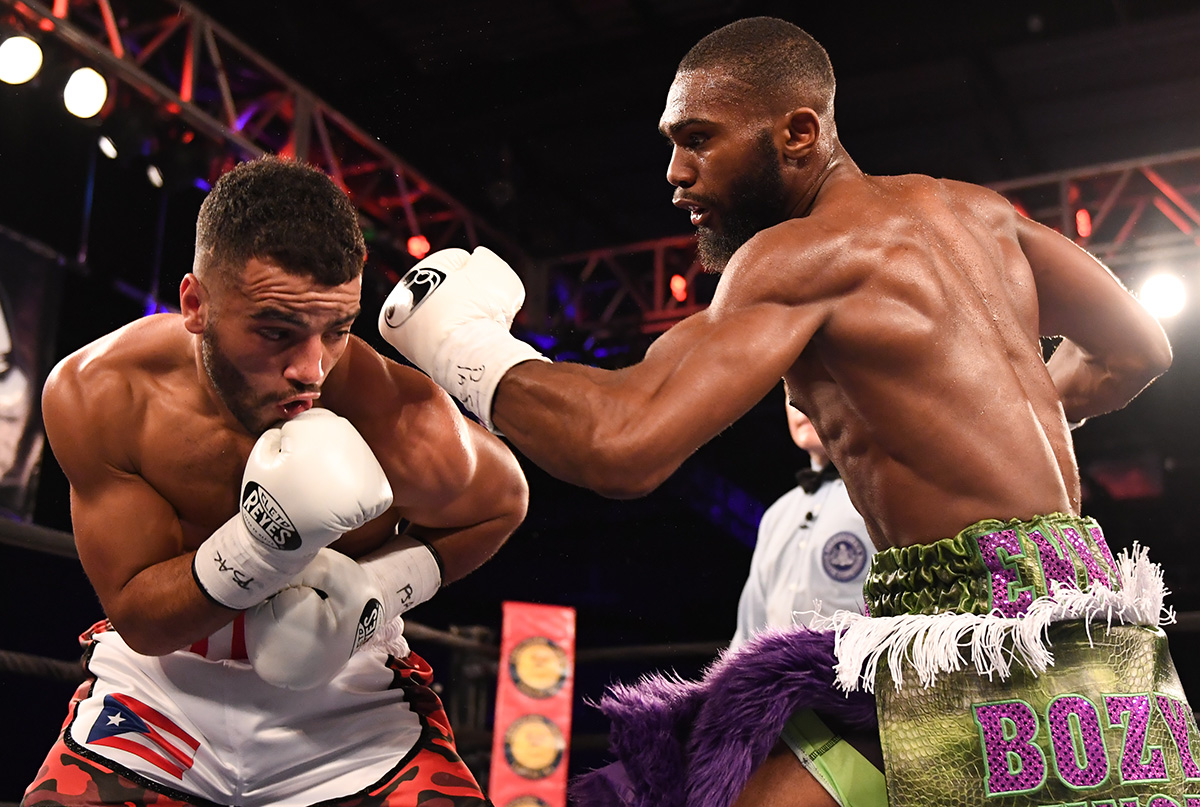
Welterweight Jaron Ennis (right) vs. Raymond Serrano. Photo credit: Matt Heasley
“My dad gave me that look,” he concluded. “I knew what to do in the second round.”
Did he ever. Ennis oozed energy, technique, confidence, discipline and strength and there was little Serrano could do to keep the avalanche of leather from burying him. The CompuBox numbers further illustrated the degree of Ennis’ command: Ennis fired 126 punches to Serrano’s 18, 59 jabs to Serrano’s 6 and 67 power shots to Serrano’s 12 but, in terms of connects, the gulfs were spectacular (44-4 overall, 13-0 jabs and 31-4 power). Also Ennis landed 35% overall, 22% jabs and 46% power, while limiting Serrano to 22%, 0% and 33% respectively. He actually faced more resistance against Alvarez, as Ennis out-threw him by smaller margins (193-150 overall, 53-43 jabs and 140-107 power) but, despite that, Ennis still created sizable gaps in connects (72-20 overall, 7-3 jabs, 65-17 power) and accuracy (37%-13% overall, 13%-7% jabs, 46%-16% power).
Is Ennis a future champion? He sure looked like one tonight.
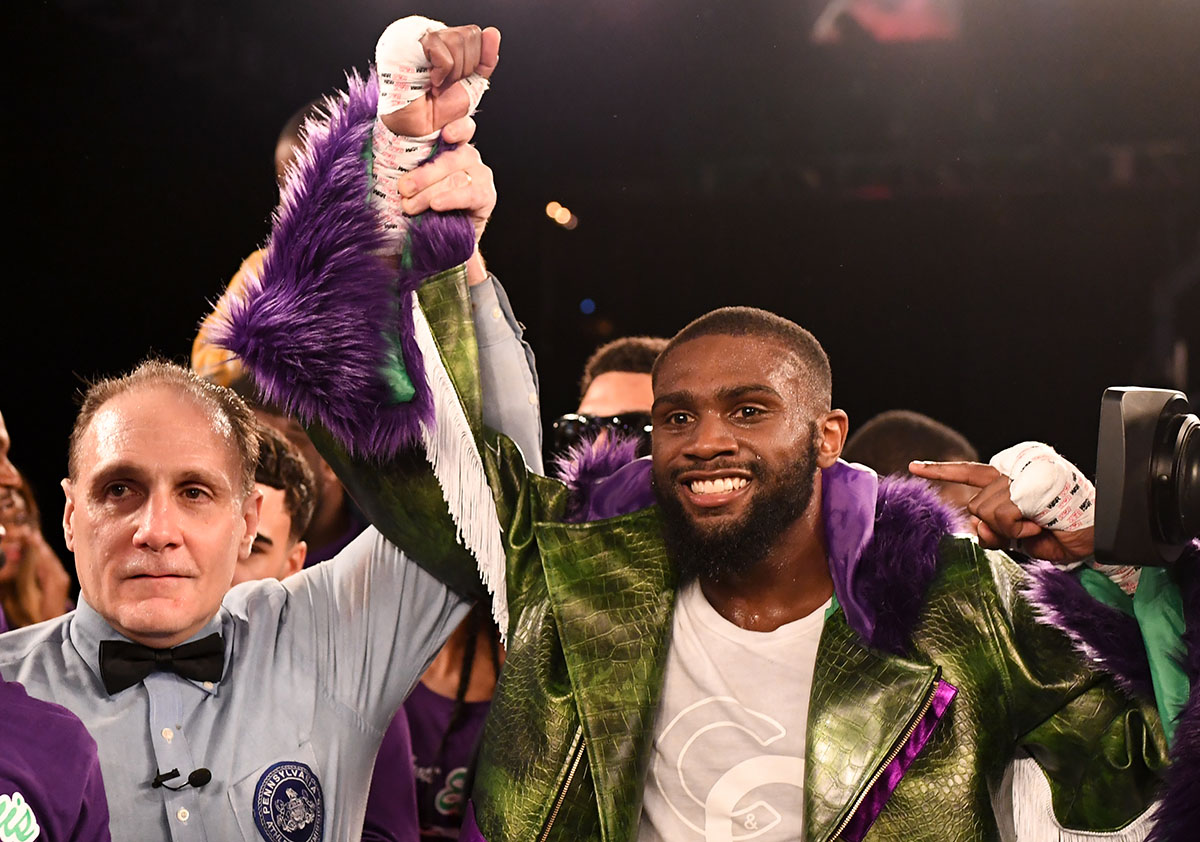
Welterweight Jaron Ennis. Photo credit: Matt Heasley
In that vein, the best news about Ennis is he has plenty of time to chart his rise to the top. He won’t turn 22 until next June and the titlists at 147 are 31 (Terence Crawford and Shawn Porter), a week away from turning 30 (Keith Thurman) and 28 (Errol Spence Jr.). The only reason that might push Ennis into chasing a title now might be a closing window, in terms of making 147 comfortably, but Ennis’ earlier quote refutes that notion. If that is true, then Ennis has time to allow his “man strength” to gather at welterweight. Given what he has done with his “son strength,” one can only shudder at what he can do once his body matures.
“Continue to keep watching me and watching me grow as a fighter,” Ennis said. “I feel like it’s time to shine and let the world know who I am.”
I, for one, am looking forward to seeing what happens next – and what happens going forward.
*
Samuel Teah is nicknamed “Tsunami” and he certainly showed why in beating the favored Kenneth Sims Jr. over eight rounds. Coming into the fight, Sims had earned the label of volume-punching specialist because, in seven previous CompuBox-tracked fights, he averaged 73.9 punches per round, while also producing excellent accuracy rates of 40% overall, 28% jabs and 44% power. And as previously mentioned in Part One, Sims’ tendency to start quickly, fade in the middle and come on strong at the end remains one of the strongest and most consistent CompuBox trends.
Teah was well aware of this, and he borrowed a play from Rolando Chinea’s playbook to conquer it: Answer fire with fire, then use even more fire to smother it.
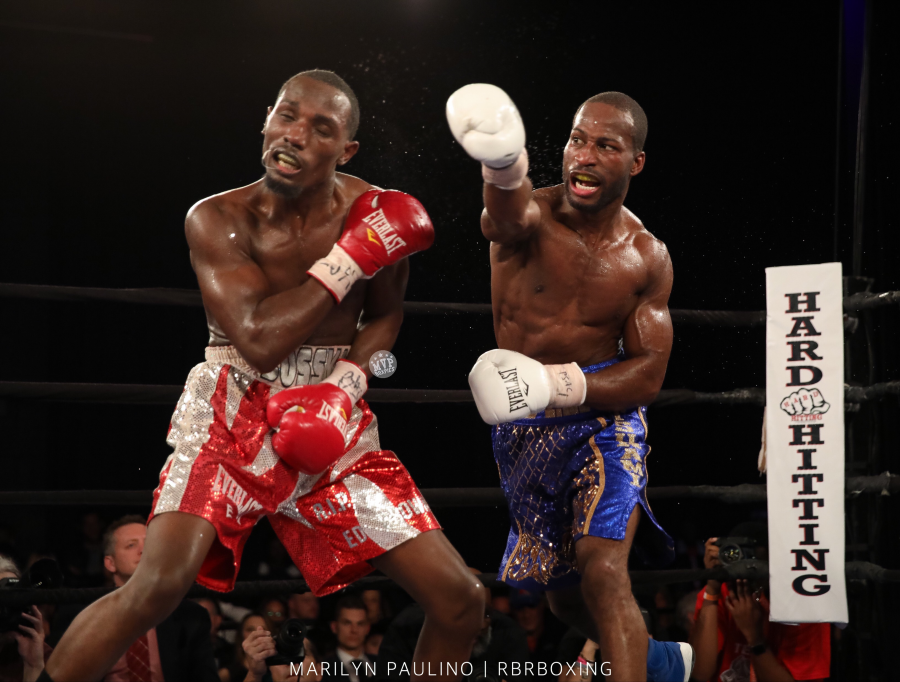
Junior welterweight Samuel Teah (right) vs. Kenneth Sims Jr. Photo credit: Marilyn Paulino/RBR Boxing
Teah, who averaged just 58 punches per round in his three other CompuBox-tracked fights, began the fight with surprising energy, as he met Sims’ 18 of 77 effort in round one by throwing 74 punches and landing 21 and Teah followed it with a sterling 35 of 98 in round two to swamp Sims’ 27 of 69. The key sequence of the match took place in round three when Teah seized on Sims’ expected throttle-down to 45 punches by cranking 79 punches and out-landing him 29-20. From there, Teah pulled away as he out-landed Sims 164-91 in rounds 3 through 8, foiling Sims’ habit of finishing strong by out-landing him 53-28 overall and 34-19 power in the final two rounds but also out-threw Sims 168-139 overall and 83-67 power during that stretch.
Teah credited a change in routine for his markedly improved performance.
“I trained differently. I made a sacrifice; I trained away from home. I ate right and (did) very minimal sparring,” Teah told Santoliquito. “I felt fresh; I thought I looked fresher. I could have fought four more rounds. I knew (Sims) didn’t have the same pace that I had for all eight rounds.
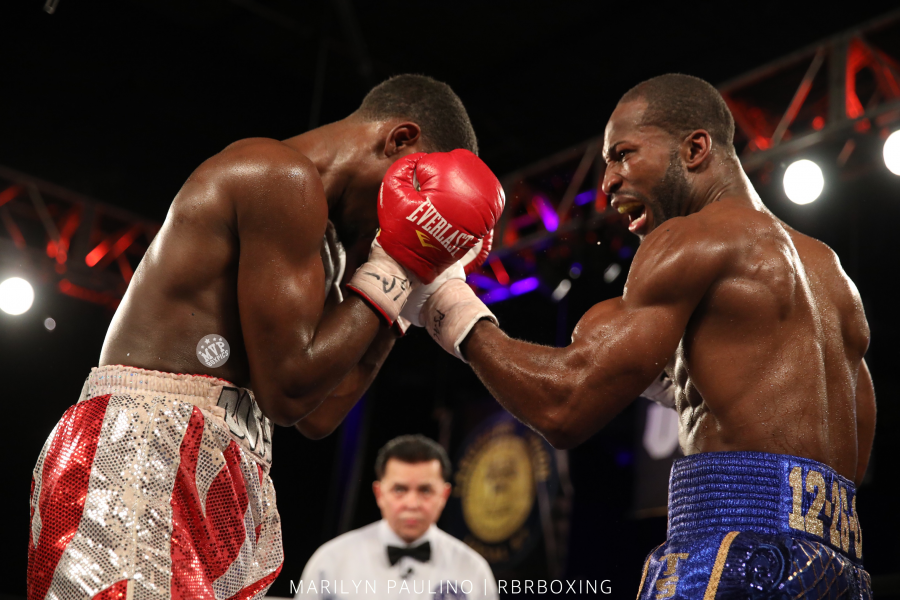
Junior welterweight Samuel Teah (right) vs. Kenneth Sims Jr. Photo credit: Marilyn Paulino/RBR Boxing
“I knew this would be my biggest stage,” he continued. “This is my best performance as a pro. The plan is to have bigger opportunities in 2019. Whatever is up next, I want it. I want bigger, better fights. I deserve it. I want 10-round fights. My legs feel fresh.”
In short, Teah epitomized the axiom “Look good, feel good, fight good.” Given the travails he encountered in his previous ShoBox appearances against Demond Brock (D 8) and Montana Love (L 8), Teah’s “good” looks better than most people’s good. If he can maintain this form, “Tsunami Sam” could create some big waves at 140 pounds.
*
Perhaps Teah took a cue from the opening TV fight between the favored Arnold Khegai and veteran Mexican Jorge Diaz, for Diaz used a mixture of high volume and constant mobility to keep the Philadelphia-based Ukrainian junior featherweight at bay. In the first five rounds, Diaz averaged a healthy 74.6 punches per round to Khegai’s 52 to forge a 92-92 tie, in terms of total connects and a 78-52 lead in landed power punches.
Diaz’s success came with a price: Blood. An accidental butt in round three opened a slice over Diaz’s right orb (as well as a small cut over Khegai’s left eye) and a subsequent head clash opened a cut on Diaz’s scalp. Khegai, however, used his excellent jab to control distance (he led 35-14 over the first five rounds) and his superior shot-for-shot power helped him stay the course, as well as a project an air of dominance to the fans and media.
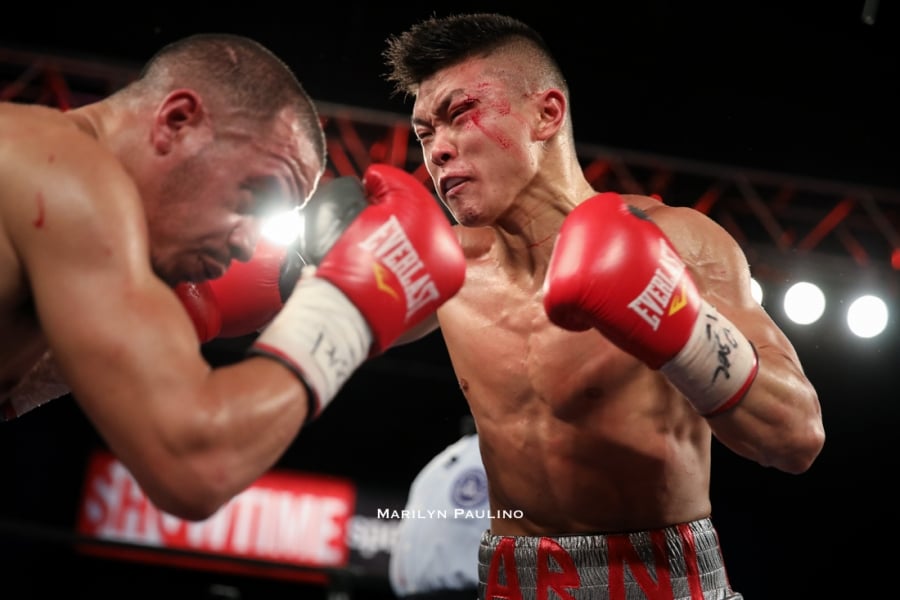
Junior featherweight Arnold Khegai (right) vs. Jorge Diaz. Photo credit: Marilyn Paulino/RBR Boxing
In round six, Khegai broke open the fight by scoring the fight’s only knockdown with a flurry that drove Diaz to his knees. Khegai out-threw Diaz for the first time in round six (61 to 51) and opened up connect margins of 20-12 overall and 15-6 power. Diaz rallied strongly in the seventh, as he throttled up to 81 punches and out-landed Khegai 18-15 overall and out-jabbed him 10-6.
Entering the eighth, the fight was statistically tied with 122 total connects by each man, though Diaz needed to throw many more punches to reach that level (505 to 379). The CompuBox round-by-round breakdown had the fight 3-3-1 in total connects, Khegai up 5-2 in landed jabs and Diaz ahead 4-3 in power connects. Theoretically speaking, the fight could have been up for grabs and a compelling closing statement needed to be made by one man or the other to nail down the victory.
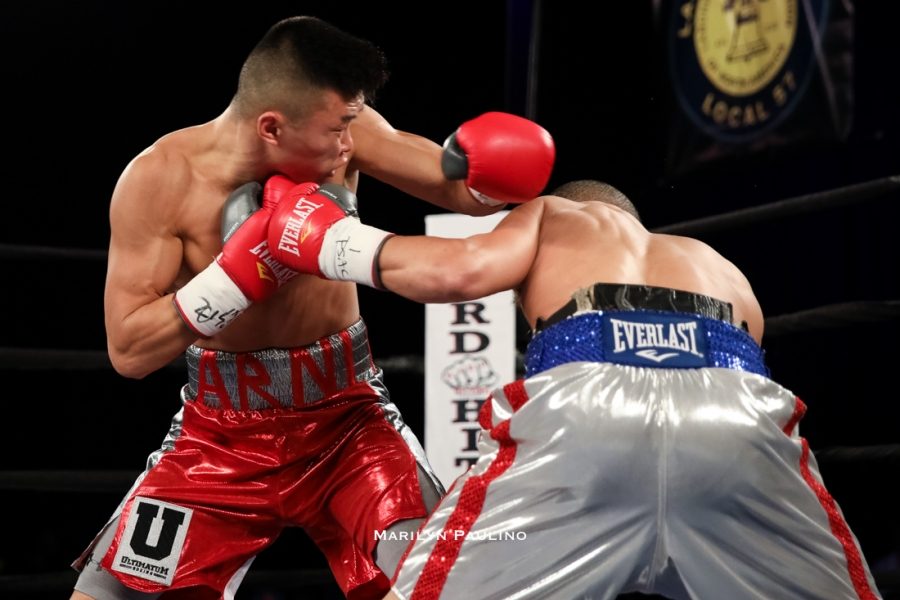
Junior featherweight Arnold Khegai (left) vs. Jorge Diaz. Photo credit: Marilyn Paulino/RBR Boxing
Khegai turned out to be that man as he out-threw Diaz 82-67, out-landed him 33-15 overall and 31-13 power, connected at higher percentages (40%-22% overall and 44%-32% power) and expanded his final leads to 155-137 overall, 48-32 jabs and 107-105 power, as well as 34%-24% overall, 34%-15% jabs and 33%-29% power.
As it turned out, Khegai was never in any danger of losing his lead, as he won 77-74 on two cards and 79-72 on the third. The ShoBox announcers correctly criticized Khegai for his “one-at-a-time” approach but Diaz’s motion and volume played a big role in making that happen. Still, Khegai delivered when it mattered – the sixth round knockdown and the eighth round rally – and the confidence he earned by doing so will surely help him in future step-up fights.
*
While Andy was more correct, in terms of how the three fights unfolded (two decisions and one KO as opposed to my guess of one decision bracketed by two knockouts), I actually came closer to the total of 18 rounds fought (I guessed 16 to Andy’s 21). Because we each had a claim to victory, our little pre-fight contest was declared a wash.
Not long after ring announcer (and longtime friend) Henry “Discombobulating” Jones made the Ennis-Serrano result official, I packed the equipment with dispatch and headed toward the back of the arena with Andy to consume a slice of post-fight pizza before heading back to the Airport Marriott. With the help of Andy (and Google Maps), I managed to navigate my way to the hotel entrance. After dropping Andy off, I drove to the Avis facility across the street, turned in the Jeep and walked back to the Marriott.
As I entered the front lobby, I saw that the TVs were showing round five of Maurice Hooker’s ultimately successful title defense against Alex Saucedo but, by the time I returned to my room and settled in, I saw just the seventh and final round. Although Hooker is the WBO junior welterweight titlist, I thought Saucedo’s home ring advantage and promotional push would help him get over the finish line. Instead Hooker scored a character-laden, off-the-floor TKO that further illustrated how unpredictable and thrilling boxing can be on a night-to-night basis.
I had toyed with the idea of calling American Airlines about changing my reservation but my post-fight energy was such that I knew I wouldn’t be able to fall asleep anytime soon. Because of that, I opted to keep my 4:29 p.m. flight and give myself the luxury of stress-free sleep. Finally at 3 a.m., I clicked off the table-side lamp and tried to get some shuteye.
Saturday, November 17: For the second straight night, my slumber was deeper and more satisfying than usual. Coincidentally I got out of bed at exactly 8:04 a.m. – the departure time of the earlier Philadelphia-to-Pittsburgh flight – and I was happy to learn that the hotel checkout time was noon because that gave me a few hours to catch up on my writing. At 11:45 a.m. I packed my things and headed down to the lobby, just one floor and a few dozen steps below the airport terminal.
After checking out, I spotted several Showtime crew members, including audio ace Tim Arden, with whom I walked to the terminal entrance. I would have followed him into the Terminal B security line but I soon learned about a change at the Philadelphia airport since my last visit: If you have TSA Pre-Check as I do, one must walk to Terminal C to use it. Since I wanted to use my privileges, we said our goodbyes and parted ways.
I passed through security without any issues and as I walked toward Terminal B (my gate to Pittsburgh, according to the monitor, was B-10), I glanced to my right and saw a Geno’s Steaks outlet. Since it was a little past noon – and because I’ve heard for years that Geno’s and Pat’s were the two best-known cheesesteak franchises in Philadelphia – I opted to satisfy my hunger, as well as my curiosity.
Being from neighboring West Virginia, I’m much more familiar with pepperoni rolls, Mister Bee Potato Chips and cole slaw on hot dogs than cheesesteaks. I asked the man in front of me, a Philly native, how he liked his sandwiches and he told me to get one with mushrooms and peppers. All in all, the sandwich was good but it was very filling. By the time I finished, I felt as if I had gained 20 pounds and that I wouldn’t feel like eating anything for quite a while.
With more than three hours to kill, I spent most of it at the gate tapping the keys on my new HP laptop, which is much thinner (and more powerful) than the “workhorse” that has slowed to a crawl in recent months. My laptop bag certainly feels lighter and more maneuverable and the ultra-quick start-up and shut-down times are much appreciated.
My time at the gate proved extremely productive, as I reached a prime stopping point a full 25 minutes before the scheduled boarding time. Also my body and brain had successfully assimilated the cheesesteak meal and, as a result, I felt a lot more like myself.
The flight home was turbulence-free but there was one small hiccup: I had hoped to spend the flight resting my eyes, so I would be sharp for the drive home, but during the food service, one of the flight attendants tapped me on the shoulder and gave me a package of cookies. Most flight attendants would skip a person with his eyes closed and some passengers in my spot would have registered annoyance with being disturbed. Me being me, however, I thanked her for the cookies and subsequently asked for a cup of Diet Coke.
The plane landed at 5:25 p.m. and I arrived home at 8:31, closing out my 16th trip of 2018. The 17th and presumably final journey of the year will be one of the most important, for I am scheduled to fly to Los Angeles and chronicle the fight between WBC heavyweight titlist Deontay Wilder and Tyson Fury, the owner of the heavyweight championship’s “line of succession,” thanks to his victory over Wladimir Klitschko nearly three years ago and the fact that he remains undefeated.
Until then, happy trails!
*
Lee Groves is a boxing writer and historian based in Friendly, West Virginia. He is a full member of the BWAA, from which he has won 16 writing awards, including two first-place awards, since 2011. He has been an elector for the International Boxing Hall of Fame since 2001 and is also a writer, researcher and punch-counter for CompuBox, Inc. He is the author of “Tales from the Vault: A Celebration of 100 Boxing Closet Classics” (available on Amazon) and the co-author of the newly released book “Muhammad Ali: By the Numbers” (also available on Amazon). To contact Groves about a personalized autographed copy, use the email [email protected] or send him a message via Facebook.
Struggling to locate a copy of The Ring Magazine? Try here or
Subscribe
You can order the current issue, which is on newsstands, or back issues from our subscribe page.


